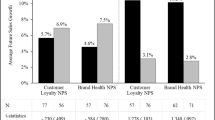Abstract
One of the puzzles of store-level scanner data is the lack of a dip in quantity sold in the weeks following a promotion. Such a dip is predicted by a consumer inventory model. During a promotion consumers buy more, not only for current consumption, but stockpile for future consumption. The predictions of such a model have been confirmed by household-level data yet seem harder to find in aggregate brand- or category-level data. We re-examine this puzzle and reach two conclusions. First, the effects at the household-level are present, but are much smaller than previously found. Our estimates are different because we control for household heterogeneity in a more general way than most previous work. This suggests that since the effects are small they might be harder to spot in aggregate data. Second, we show that the dip is present in the aggregate data, once we control for additional promotional activity, like feature and display. The latter has an opposing dynamic effect that masks the existence of the post-promotion dip.
Similar content being viewed by others
References
Arrow, K., T. Harris, and J. Marschak. (1951). “Optimal Inventory Policy”, Econometrica 19(3), 250– 272.
Bagwell, K. (2002). The Economic Analysis of Advertising, forthcoming Handbook of Industrial Organization.
Bell, D., J. Chiang, and V. Padmanabhan. (1999). “The Decomposition of Promotional Response: An Empirical Generalization”, Marketing Science 18, 504–526.
Bell, D. and J. Lattin. (1998). “Shopping Behavior and Consumer Preference for Retail Price Format: Why 'Large Basket' Shoppers prefer EDLP”, Marketing Science 17, 66–88.
Blattberg, R., G. Eppen, and J. Lieberman. (1981). “A Theoretical and Empirical Evaluation of Price Deals in Consumer Nondurables”, Journal of Marketing 45, 116–129.
Blattberg, R. and S. Neslin. (1989). “Sales Promotion: The long and Short of It”, Marketing Letters 1, 81– 97.
Blattberg, R. and S. Neslin. (1990). Sales Promotions. Prentice Hall.
Breusch, T. and A. Pagan. (1980). “The Lagrange Multiplier and Its Implications to Model Specification in Econometrics”, Review of Economic Studies 47, 239–253.
Chevalier, J., A. Kashyap, and P. Rossi. (2000). “Why Don't Prices Rise During Peak Demand Periods? Evidence from Scanner Data”, American Economics Review 93(1), 15–37.
Chiang, J. (1991). “A Simultaneous Approach to the Whether, What and How Much to Buy Questions”, Marketing Science 10, 297–315.
Currim, I. and L. Schneider. (1991). “A Taxonomy of Consumer Purchase Strategies in a Promotion Intense Environment”, Marketing Science 10, 91–110.
Erdem, T., S. Imai, and M. Keane. (2003). “Consumer Price and Promotion Expectations: Capturing Consumer Brand and Quantity Choice Dynamics under Price Uncertainty”, Quantitative Marketing and Economics 1, 5–64.
Grover, R. and V. Srinivasan. (1992). “Evaluating the Multiple Effects of Retail Promotions on Brand Loyal and Brand Switching Segments”, Journal of Marketing Research 29, 76–89.
Gupta, S. (1988). “Impact of Sales Promotions on When, What, and How much to Buy”, Journal of Marketing Research 24, 342–355.
van Heerde, H., P. Leeflang, and D. Wittink. (2000). “The Estimation of Pre-and Postpromotion Dips with Store-Level Scanner Data”, Journal of Marketing Science 37, 383–395.
Hausman, J. (1978). “Specification Tests in Econometrics”, Econometrica 46(6), 1251–1271.
Hendel, I. and A. Nevo. (2002a). “Sales and Consumer Inventory”, NBER Working Paper no. 9048.
Hendel, I. and A. Nevo. (2002b). “Measuring the Implications of Sales and Consumer Stockpiling Behavior”, University of California, Berkeley, mimeo.
Hsiao, C. (1986). Analysis of Panel Data. Cambridge University Press.
Lattin, J. and R. Bucklin. (1989). “Reference Effects of Price and Promotion on Brand Choice Behavior”, Journal of Marketing Research 26, 299–310.
Moriarty, M. (1985). “Retail Promotion Effects on Intra-and Inter-brand Sales Performance”, Journal of Retailing 6, 27–48.
Neslin, S., C. Henderson, and J. Quelch. (1985). “Consumer Promotions and the Acceleration of Product Purchases”, Marketing Science 4(2), 147–165.
Neslin, S. and L. Schneider Stone. (1996). “Consumer Inventory Sensitivity and the Postpromotion Dip”, Marketing Letters 7, 77–94.
Neslin, S. and R. Shoemaker. (1983). “A Model for Evaluating the Profitability of Coupon Promotions”, Marketing Science 2, 361–388.
Pesendorfer, M. (2002). “Retail Sales. A Study of Pricing Behavior in Supermarkets”, Journal of Business 75, 33–66.
Shoemaker, R. (1979). “An Analysis of Consumer Reactions to Product Promotions”. In Educators' Conference Proceedings. Chicago: American Marketing Association, 244–248.
Author information
Authors and Affiliations
Rights and permissions
About this article
Cite this article
Hendel, I., Nevo, A. The Post-Promotion Dip Puzzle: What do the Data Have to Say?. Quantitative Marketing and Economics 1, 409–424 (2003). https://doi.org/10.1023/B:QMEC.0000004844.32036.5a
Issue Date:
DOI: https://doi.org/10.1023/B:QMEC.0000004844.32036.5a




